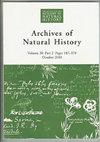十八世纪用于运输和保存自然历史标本的木桶
IF 0.2
4区 哲学
Q3 HISTORY & PHILOSOPHY OF SCIENCE
引用次数: 0
摘要
在运输活体和保存下来的标本时,博物学家通常会非常小心地决定如何以最佳方式运输。最重要的运输方式之一就是木桶运输。在十八世纪,许多博物学家,包括约瑟夫-班克斯、约翰-埃利斯和勒内-安托万-费尔乔-德-雷奥穆尔,都提倡使用或使用木桶来运输标本,因为长途航行经常会导致标本损坏或毁坏。本文将研究博物学家使用木桶的情况,并详细介绍这种无处不在的物品是如何在自然史的发展史上发挥异常重要的作用的。本文章由计算机程序翻译,如有差异,请以英文原文为准。
Wooden barrels for transporting and preserving natural history specimens in the eighteenth century
When transporting specimens, both living and preserved, naturalists often took great care when deciding how best to ship them. One of the most important shipping methods was in wooden barrels. In the eighteenth century, many naturalists, including Joseph Banks, John Ellis, and René Antoine Ferchault de Réaumur, advocated the use of, or used, barrels to transport specimens when long voyages often caused specimens to become damaged or destroyed. This paper will investigate the use of wooden barrels by naturalists and detail how such a ubiquitous object proved to be exceptionally important in the history of natural history.
求助全文
通过发布文献求助,成功后即可免费获取论文全文。
去求助
来源期刊

Archives of Natural History
HISTORY & PHILOSOPHY OF SCIENCE-
CiteScore
0.40
自引率
50.00%
发文量
34
审稿时长
>12 weeks
期刊介绍:
Archives of Natural History (formerly the Journal of the Society for the Bibliography of Natural History) publishes peer-reviewed papers on the history and bibliography of natural history in its broadest sense, and in all periods and all cultures. This is taken to include botany, general biology, geology, palaeontology and zoology, the lives of naturalists, their publications, correspondence and collections, and the institutions and societies to which they belong. Bibliographical papers concerned with the study of rare books, manuscripts and illustrative material, and analytical and enumerative bibliographies are also published.
 求助内容:
求助内容: 应助结果提醒方式:
应助结果提醒方式:


